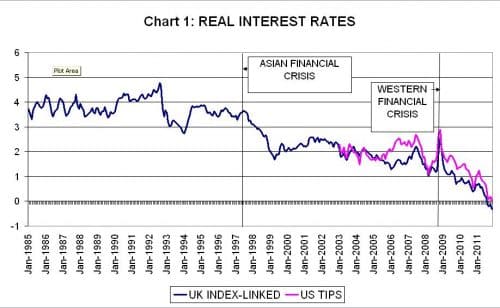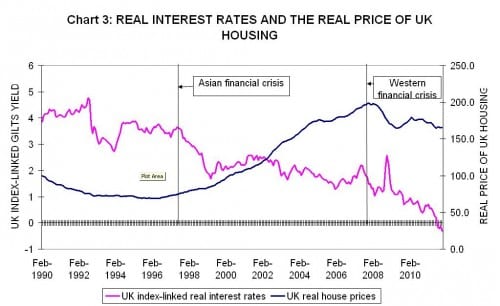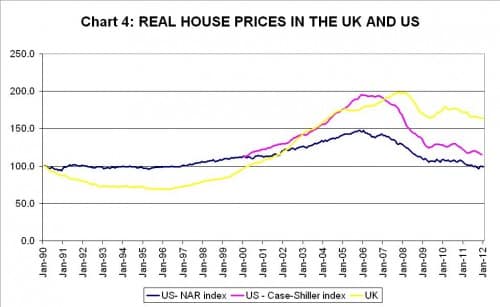More on financial repression
One commenter on today’s daily commentary mentioned financialization as a reason we are seeing commodity prices through the roof. This makes a lot of sense since commodities are now an alternative asset class in the financial supermarket for investors and speculators alike. But it is also clear that funds have moved into alternative investments as yields have come down because the opportunity cost of holding these assets has diminished as fixed income assets yield next to nothing.
Gold has done well for just this reason. It is not that gold is an inflation hedge per se but rather it is a hedge against low and negative real rates. When real interest rates are low, the opportunity cost for holding gold is diminished and gold does well. When real yields are high, gold does not do well. Think of it this way: when the cost of holding a non-interest bearing asset compares favourably to the opportunity cost of giving up fixed income returns, people are going to shift portfolio preferences and that is what we have seen. It is risk seeking return. This I believe is the intended consequence of policy because the shift into higher risk favours asset prices generally and policy makers want assets to remain elevated.
But all assets benefit from this shift including commodities. Monetary authorities are in a real bind because they want (and need) house prices to remain elevated for longer. I think financial repression will last for years because it is a solution used to avoid the consequences of writing debt down and that means the workout will be protracted.
Now, Martin Wolf had an interesting take on the subject in the FT in an article called What is the real rate of interest telling us? Here’s what he writes about real yields in the UK:
We can then clearly see that the last 27 years breaks down into three clear sub-periods: from January 1985 to January 1998, the real interest rate averaged 3.7 per cent; from January 1998 to August 2007, it averaged 2.1 per cent; and then since August 2007, when the financial crisis began, it has fallen steadily, to below zero, with a brief interruption during the period of high panic from October to December 2008.
Now, Wolf goes on to explain the drop in real yields as an outgrowth in part of the so-called Asian savings glut.I don’t buy this explanation (see here and here). And he then goes on to talk about the fall in investment in the developed economies post Internet bubble where I think he is getting on the right track. I see the shift in real rates down as an outgrowth of the debt bubble and incipient financial repression to reflate the economy. While things were fairly normal in the late 1980s and the early 1990s, by the time the recession of 2000 hit, the reflation paradigm had to be very aggressive to get stimulus into the economy. We see this now as the whole decade of the 2000s failed to create jobs despite the Bush tax cuts, 1% rates at the Fed and all manner of other stimulus.
What happened instead is that an asset bubble, a property bubble, inflated. Wolf writes:
The coincidence between the fall in the real rate of interest in 1997-99 and the beginning of the bull market in housing in the US and UK is indeed remarkable. The collapse in real interest rates also helped exaggerate an already impressive bull market in equities, which topped out, at extraordinarily overvalued levels, in 2000.
Thus the world of the pre-crisis savings glut had two fundamental characteristics: a long bull run in housing and low returns on safe real assets. This was the “ideal” environment for an expansion of property-backed leverage on an exceptional scale.
That property-backed leverage then went into reverse as soon as house prices started to decline, which they did, in the US, in 2006. The subsequent collapse of the over-leveraged financial system and cut-backs on construction and household spending in affected economies generated a deep recession.
That collapse then led to an even bigger ex ante savings glut and so to a further decline in the real interest rate on safe assets to the depressed levels we see today.
What Wolf calls a savings glut is what I am calling malinvestment-induced savings. call it whatever you want, what is clear is that low to negative real yields have negative unintended consequences.



Comments are closed.